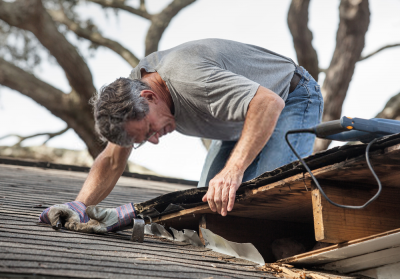Tips on Selling a House that Needs Repairs

Selling your home is rarely a cut and dry process. There is market competition to contend with, seasonal ebbs and flows, and a whole host of other factors that can complicate the speed and stress level associated with a sale. And then there is the property itself. Homes take on a lot of wear and tear, and much of it is quite expensive to fix. A lot of sellers find themselves going on the market with one or more repairs that need to be taken care of and which they don’t want to deal with themselves. But how do you sell a home that needs repairs, especially if they’re major?
If you’re trying to sell a home that needs repairs and you’re trying to sell fast, you’re probably going to have to make concessions when it comes to addressing the fixes that need to take place around the property. Other sellers might find a different approach works best. To help you figure out your own best course of action, read through what you need know about trying to sell a home that needs repairs, including what your options are.
Putting Repairs Into Perspective
You probably already have a pretty good idea of what repairs are needed on your house, but it’s always a good idea to map out exactly what’s on the docket and to make distinctions between small repairs and large ones. Keep in mind that you will be obligated to disclose to interested buyers all of the issues that you are aware of.
Working on your own or with your realtor, prioritize your list of repairs, starting with high-priority repair needs such as fixing a mold problem, and ending with low-priority repairs like chipped grout in the master bath. Making this list will help you get a big picture view of the repairs that your home needs and can help you figure out what you might want to tackle on your own for a successful sale.
The more thorough you can be with this list, the better. Sometimes fixing low-priority repairs can offset the impact of high-priority ones. Plus, an interested buyer is going to find out about your home’s repair needs anyway during a home inspection. Whatever you can take care of now is one less thing you have to worry about accommodating later on.
Take Care of Non-Negotiable Repairs
Some repairs are major safety issues that are almost certainly going to stand in the way of your sale. This leaves you with an option: take care of them now and then list, or struggle to sell and deal with them later.
So what are non-negotiable home repairs? These are some of the issues that could prohibit you from being able to sell your home:
-
- Mold and pest problems
- Leaking roofs
- Outdated/unsafe electrical work
- Broken pipes or other major plumbing issues
- Cracked or otherwise damaged foundations
Of course, if you don’t want to deal with fixing these issues yourself, you could simply lower the asking price a considerable amount to cover repairs for the buyer. However, not all buyers want that — even if comes with a price drop — so you could be hurting your chance at a sale.
Options When You’re Trying to Sell a Home That Needs Repairs
Plenty of people sell homes that need some work, even if it’s not always as easy as selling homes that don’t. How they go about it varies, though. Work with your realtor to determine what your best option is, taking into account the extent of the repairs that need to be made on your home and the current market that you’re looking to sell in.
Here are a few of the options that you can consider.
Take care of the big repairs. If your timing and budget allow, then you may want to just deal with the high-priority repairs on your own and remove those issues from the equation. Buyers can often see past smaller repair needs if they know that they’re not going to have to take on anything major. It likely won’t be cheap, but it could make all the difference when it comes to selling your home in a reasonable time period.
Take care of the small repairs. Alternately, you could put your time and money toward the lower-priority repairs, once again shifting the balance a bit so that potential buyers can wrap their heads around what needs to be done instead of being hit with a barrage of repair needs. This serves another function too, since buyers may be more willing to spring for larger repairs on their own if the cosmetics of the home meet their expectations. Be prepared though to still set a price that acknowledges the major repairs that are needed—aesthetic improvements are great, but they don’t erase the fact that there are some big expenses required.
Sell the home “as is.” When you list a home “as is,” you’re signifying to the buyer that you’re aware of the state of the home but you’re not going to be making any changes to it. Buyers who opt to move forward with an “as is” home have an understanding that they won’t have much negotiation room post-home inspection, and that they’re taking a bit of a risk. How do you get buyers to bite then? You have to be very strategic with your listing price, keeping it low enough that people who are interested in your home still see it as a good deal.
Find someone interested in a fixer upper. If you’ve ever turned on HGTV then you know that there are plenty of buyers who see value in purchasing a fixer upper. If you’re trying to sell a home that needs repairs but is in a super popular neighborhood you should have some luck with this, and the same goes for if you’re marketing to people who flip homes for a living. Keeping on theme though, you’re going to have to keep your expectations in line as far as asking price goes—a fixer upper costs only as much as its current state, not its future potential.
Find an interested investor. Real estate investors and real estate investor companies will pick up your home for a cash payment, often even in spite of it needing extensive repairs. These types of buyers purchase homes as part of an investment strategy, so like those who buy fixer uppers their plan is probably going to be to flip the house and sell it for a higher profit. While you do get an instant sale with few (if any) contingencies, you’ll probably end up selling for well below market value.
Figuring out what you should do if you want to sell a home that needs repairs is not a decision that should be made overnight. Carefully weigh the pros and cons, determining whether it would be more cost effective to cover repairs yourself than to take a price drop. If the latter makes more sense for you, then you can decide whether a fast sale through a real estate investor or a more traditional approach is a better fit.
Throughout the decision-making process, work closely with your realtor to figure out what gets you the most bang for your buck—and what’s most likely to end up in a successful sale. Repairs aren’t a de facto dealbreaker on the housing market, but they do complicate things. If you keep your expectations in line though, you shouldn’t come up against any surprises.
Thinking of selling your home?
If you’re thinking of selling your home in norwalk connecticut area and need some help, we’re here for you.
Ruspini Realty has over 15 years of experience in buying and selling homes in Fairfield County, New Haven County,
Litchfield County and adjacent areas.
